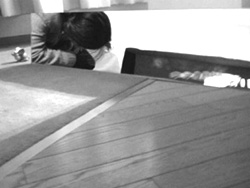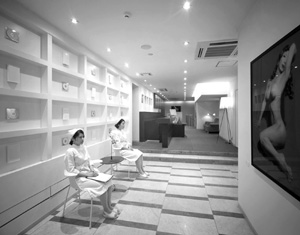|
|
A remarkable tautology has become the norm in the art world within the last 50 years—the creation of works of art for spaces created for works of art. Despite repeated attempts to break free of the white cube, art gazes at its navel and wonders why it cannot make more inroads into politics, popular culture, religion—into life.
Stay with Art is one of a growing number of exhibitions which addresses this issue, attempting to bridge the gap between art and life by bringing art back into the spaces of everyday life—of leisure, of work, of love, of sex, of government, of worship. Anything, that is, but the neutral space of the white cube. This exhibition, which took place at the T’Point Hotel in Osaka, was the second experiment in a series of exhibitions organized by Megumi Matsuo, a figure associated with Dumb Type who established one of the first artist-run spaces in Japan—the Voice Gallery in Kyoto. Outside of the museum establishment, this project not only created new relationships between art and the viewing public, but also allowed works previously censored by museums (Morimura’s Black Marilyn and Kuwajima’s The Life) to be shown by finding private sponsors unhampered by nervous boards and city politicians.
For three days, each participating artist was given a room in the T’Point, a hotel whose interior was designed by SAGESHIMA Seiji. They were each given the liberty to create their own site-specific installation—to make a total environment in which the audience could sit, relax, talk to their friends, be a voyeur, steal a kiss, or speculate about what it would be like to do so.
 |
|
KIMURA Yuki, Questions from Anne Frank. If you were marooned on an island, would you still choose something to wear today?, 2001.
|
In Muted Space, Room 213, the Dumb Type member TAKAMINE Tadasu created a bed surrounded by computer symbol studded mirrors into which the audience was invited to sink. Surrounded by repeated images of oneself and other viewers interposed with electronic symbols—as if stuck in a kinky fiber optic cable or love hotel—one felt the absence of the museum’s protective varnish, and the vulnerability of being in bed with strangers. Similarly, KIMURA Yuki played upon the idea of the hotel being a matrix of transience, openness, voyeurism, and fears with her installation Questions from Anne Frank; If you were marooned on an island, would you still choose something to wear today? With stuffed animals lying about and a calming video projection of a beach on the room’s main television, room 214 seemed at first almost banal. It wasn’t until one looked closely at a small mirror at ground level, facing the bed, that one realized that the apparently halcyon space was haunted by fear, by the video projection of a young girl crawling about under the bed, trying not to be seen.
MORIMURA Yasumasa expanded upon his notion of art as therapy, stationing attendants dressed as nurses and doctors around his installation. Audience members were invited to choose a CD, which they would listen to in a small room, hosted by the artist. Sound artists Rogues’ Gallery also used music, or rather, music dissected by movement to create the exhibition’s most dystopian environment. Like Dada simultaneous poetry, which layered French, German, and English to transform language into sound, Rogues’ installation used DJ turntable tactics to interrupt and mix sound from three different sound systems which brought the jumble of the streets of Osaka into the hotel, rendering it as urban poetry.
Two other rooms pondered the character of urban life, in particular examining the distance growing between urban life and nature—KUWAJIMA Hideki’s The Life and INOUE Shinta and MAEDA Shijirou’s Sheep Project. In Room 412, Kuwajima installed everyone’s favourite adolescent joke—the goldfish in a blender—beautifully photographed and chillingly aestheticized, making real the cruelty of urban humour, and its distance from the visceral reality of death. Inoue and Maeda’s Sheep Project similarly plays upon urban perceptions of animals which are, particularly in Japan, viewed as cute, cuddly cartoon characters. There exists an entire industry of sheep-themed soaps, cushions, lamps, bedspreads, pyjamas and carpets, with which the pair decorated the room. On video screens, however, the viewer experiences a totally different relationship to animals when the artists participate in a sheep sacrifice in Mongolia. Our synthetic relationship to nature is further underlined by a series of hilarious performances in which the artists set up herds of life-sized sheep cut-outs in various idyllic Mongolian landscapes in order to photograph them, running after them as they blow away in the wind.
It is often said that when looking at art in Tokyo, one can identify which artist wants to be famous, which wants to be rich, and which wants to be rich and famous. In Kansai, it seems that the goals are a little different. Perhaps a legacy of the Gutai, Kansai artists seem to want to change our lives—to change how we see ourselves, our community, and our environment, not to mention the boundaries of art. The title of the exhibition, then, Stay with Art is not simply a call to the converted to integrate art with life, but also a call to those who are losing faith in contemporary art—to those who never had faith in it to begin with. It is a plea to stay with it, to stay, with art.
STAY WITH ART
TPoint Hotel, Osaka, Japan
November 23 through 25, 2001
|
|
|

